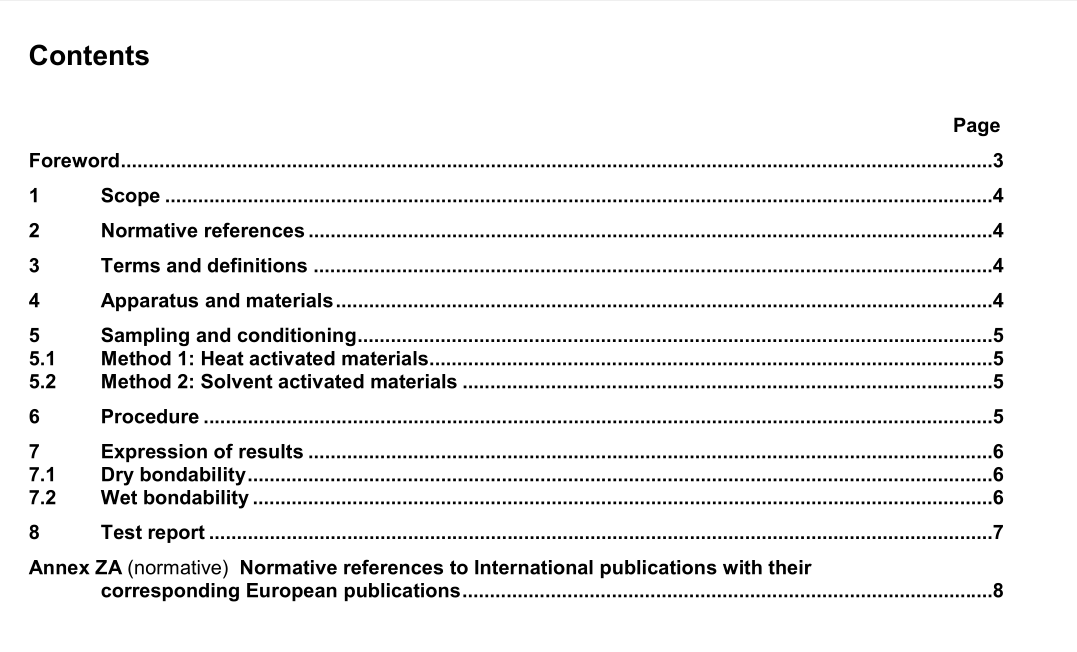BS EN ISO 20863 pdf download

BS EN ISO 20863 pdf download Footwear — Test method for stiffeners and toepuffs — Bondability
This document specifies a method for the determination of the bondability of heat activated and solventactivated stiffeners and toepuffs to upper and lining materials.
2Normative references
The following referenced documents are indispensable for the application of this document. For datedreferences, only the edition cited applies. For undated references, the latest edition of the referenceddocument (including any amendments) applies.
EN 12222,Footwear – Standard atmospheres for conditioning and testing of footwear and components forfootwear.
EN ISO 3696, Water for nalytical laboratory use – Specification and test methods (/SO 3696:1987)
EN ISO 4048, Leather一 Determination of matter soluble in dichloromethane (SO 4048:1977)
EN ISO 7500-1, Metallic materials Verification of static uniaxial testing machines Part 1:Tension/compression testing machines — Verification and calibration of the force-measuring system (ISC7500-1:2004).
3Terms and definitions
For the purposes of this document, the following terms and definitions apply.
bondabilityaptitude of a material to be bonded to it self or to other material by applying pressure and/or heat andeventually adhesive.
Apparatus and materials4
4.1 General
The following apparatus and materials shall be used.
4.2Tensile testing machine with a jaw separation rate of 100 mm/min * 10 mm/min, an appropriate forceange (this will usually be less than 100 N), capable of measuring the force to an accuracy of better than 2 as specified by class 2 in EN ISO 7500-1, which registers the force applied in terms of the displacement.
4.3Press knife or other means of cutting rectangular test specimens of (150 mm : 10mm) X(30 mm + 2 mm).
4.4Press with the following characteristics
4.4.1Heated plates which can maintain a pre-established temperature with a precision of : 5 C
4.4.2Operating pressure of 245 kPa 5 kPa (245 kPa are 2,5 kg/cm’)
Reference leather, full chrome splits (thickness of 1,5 mm to 1,7 mm) with a grease content of 4 % in4.5total fat and 1 % in fatty acid (see EN ISO 4048).
4.6Non-woven fabric,150 g 20 g per square metre.
Water distilled or deionised complying with grade 3 of EN ISO 36964.7
5 Sampling and conditioning
5.1 Method 1: Heat activated materials
5.1.1 Cut suficient strips of (150 mm t 10 mm) x (30 mm t 2 mm) from the sample and the correspondingstrips of the same size from the non-woven fabric and the reference leather (4.5) or the material to be used.
5.1.2 Make a “compound test piece” of leather-sample-non-woven fabric. A strip of paper is placed on oneof the short sides between the leather and the sample, so that 20 mm remain unstuck and so that the endscan be held in the iaws of the tensile testing machine.
NOTEThe side of the material to be tested should be that in contact with the standard leather, i.e. the side that in theshoe will be in contact with the upper leather.
5.1.3Unless the manufacture establishes the application conditions, follow the Clauses 5.1.4 and 5.1.5.
5.1.4 Place the compound test piece between both press plates heated to 70 °C +5 C, and apply apressure of 245 kPa 5 kPa for 10 s.
5.1.5Repeat the procedure described in sections 5.1.2 and 5.1.4 with the other test pieces and both pressplates heated to 90 C +5C, 110 C + 5 C, 130 C 5 and 150 5C, respectively.
5.1.6Condition the set test pieces in a conditioned environment as specified in EN 12222 for 24 h
5.2 Method 2: Solvent activated materials
5.2.1Cut at least two strips of (150 mm : 10 mm) x (30 mm : 2 mm) from the sample and two strips of thesame size from the non-woven fabric and the reference leather (4.5) or the material to be used.
5.2.2Activate the test specimen by applying acetone or other solvent (4.7) to it until it is uniformly wetted.
then leave it for 2,5 min + 0,5 min.









